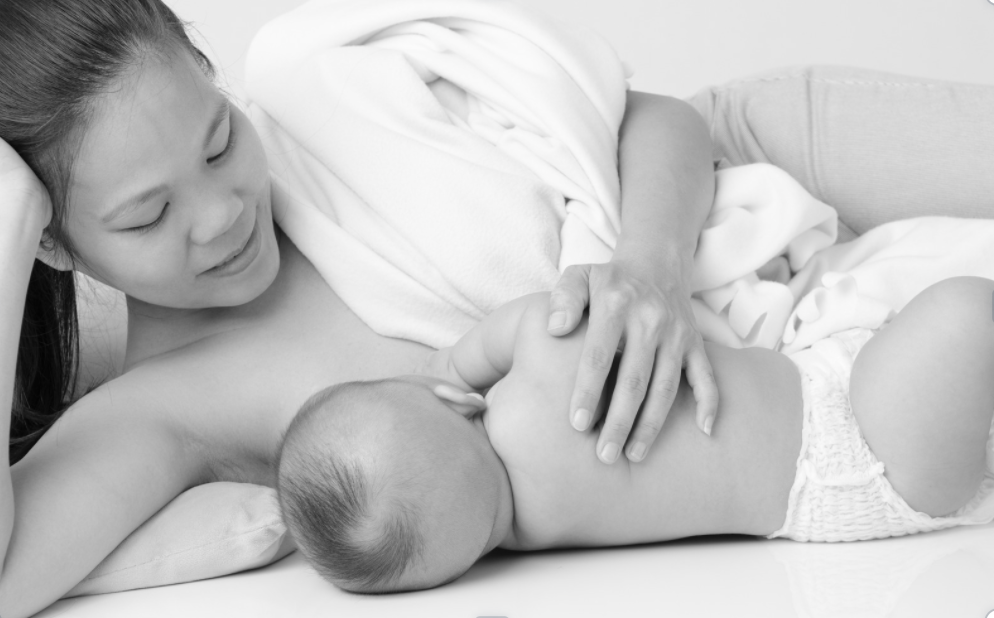
Ask DadPad, Infant Feeding, Parenting Advice
Ask DadPad: How can I help my partner with breastfeeding positions and attachment?
Posted on 19th November 2021
Today’s blog post – for #InternationalMensDay, which this year has as its theme: Better relations between men and women – is another in our series of dad-focused guides to breastfeeding. After all, being a supportive partner to a breastfeeding mum is a great way to build your relationship as parents and help give your baby the best start in life. In previous blog posts, we’ve looked at providing dads with an overview of some of the key ways in which you can support your breastfeeding partner, a look at some of the myths that surround breastfeeding, and a quick look at how breastfeeding works. To counter the common worry that breastfeeding stops dad and baby from bonding, we’ve also looked at how to bond with your baby.
Written by team member Georgie, who (amongst other things) is a Birth and Postnatal Doula, a local breastfeeding peer support volunteer and former MVP Chair, today’s blog aims to provide dads with a useful overview on two areas of breastfeeding ‘practice’ which can be key to its success: how to get good attachment (or latch), and the different positions for mum and baby to feed in.
The importance of your role as a positive breastfeeding supporter
It’s important to remember that only your partner should get to decide if their breastfeeding journey needs to end or not – it is their body after all. In recent research it was found that 80% of women that had stopped breastfeeding, had stopped before they felt ready, due to feeding challenges or lack of support. So, if you are presented with a situation where your partner is experiencing challenges or are doubting themselves, think back to what you know about their feeding aspirations and goals (this is a really good thing to discuss together, as a couple, in the run-up to your baby being born, so that you each know the other’s views), listen to them, and make sure you ask them what they would like to do before you offer any opinions or solutions. Telling your partner to just switch to bottle-feeding if they ultimately want to breastfeed can feel really dismissive of the effort they are putting in and does not provide a useful solution for them.
One of the things that dads can do that is particularly useful for their breastfeeding partner is to be a second pair of eyes and ears. Although you aren’t a trained professional, much of what breastfeeding support revolves around is watching feeds and making little adjustments to the baby’s positioning and attachment (the way your baby is being held and how they are attaching themselves to the breast). Sometimes, as the person feeding the baby, it can be difficult to see what is going on but, as dad, you are in the perfect position to check feeds from lots of different angles and give good feedback. Also, receiving professional support can sometimes be quite an overwhelming experience, so having a loving and supportive partner there to help remember all the hints, tips and suggestions is really helpful when you’re back at home.
What kind of things could you be looking out for when your partner is breastfeeding?
There’s a number of things – almost a little ‘checklist’, if you like – which you could look out for and check, especially in the early days when breastfeeding is still being established, and/or your partner is struggling a little:
- Does your partner look comfortable? Mum’s arms and shoulders need to be relaxed and their thighs need to be parallel to the floor. Use pillows, cushions, and a foot prop to help them get into a comfortable position to feed.
- Is baby’s head and body in a straight line? Babies can’t swallow well if their head, neck or body is twisted (have a go yourself when you next have a drink). Their head, neck and body needs to be fully aligned, at whichever angle they are being held.
- Is baby close enough to mum? Your baby needs to be facing your partner’s breast, with their arms wrapped around it. Baby should make full contact with your partner’s body and be kept there by an arm or hand to support their back and shoulders.
- Is baby being brought to the breast, or the breast being brought to the baby? If your partner is leaning their breast in or moving it around to reach your baby’s mouth, it’s unlikely that it will result in a comfortable, good quality feed.
- Has baby taken a good mouthful of breast tissue? For this to happen, baby needs to be facing the breast at nose level and be free to tilt their head back, so they can open their mouth wide and latch on, leading with their chin. Your partner’s nipple is aiming for the upper back part of the baby’s mouth, away from the hard palette (the bit at the front of your baby’s mouth). If you and/or baby’s mum aren’t sure about how this works, have a look at this great video, from the Scottish Government:
- Is baby’s head or neck movement being restricted? Holding your baby’s neck or head will stop them from being able to tilt their head back and open their mouth wide, resulting in a shallow latch, frustrated baby and nipple damage.

Breastfeeding positions
Another useful thing for dads to know about are different breastfeeding positions.
When breastfeeding is new to your partner and they are recovering from the birth, it can be difficult to manoeuvre the baby around without an extra pair of hands. Different breastfeeding positions offer different benefits and ways of positioning baby on the breast, so it’s a good idea to try a few different positions out and see what works best for your partner and your baby.
If you and your partner have tried several adjustments or attempts to feed your baby in a certain position, just switch it up and try something else rather than it letting get the better of you. Sometimes, trying a different position is all that is needed to shift an overwhelming or challenging feed into a feed that is comfortable and successful.
And always remember that your Health Visitor and other health professionals around your family in the early days following birth will be more than happy to sit with you and help out with different positions and attachment, too, if needed.

What breastfeeding positions are there?
- Laidback Feed: The laidback feeding position supports all your baby’s natural feeding reflexes and offers a relaxed feeding position for your partner. This position is particularly useful for those first few feeds and/or when mum is recovering from a caesarean section or stitches. Help your partner lie back in a reclined position on a bed, sofa or chair, so that she can get comfortable. You can use pillows to support her back, neck and arms. Place your baby tummy down onto your partner’s tummy, with their head in-between your partner’s breasts. As the baby lies there, gravity will help them keep their position securely on mum’s body. Your baby will then begin to smell and ‘feel’ their way to over to your partner’s nipple, all on their own. Once they find it, they will bob their head back and forth, open their mouth wide, latch on and begin to nurse.
- Cradle Hold: This position involves your partner sitting upright or semi-reclined, with baby positioned on their side, with their head and neck lying along your partner’s forearm, on the same side as they will be feeding from, with their bodies close together. Although it’s a very popular position, it’s not always the easiest to do with a newborn because it doesn’t give your baby as much support as some other holds can. A feeding pillow across your partner’s lap to help prop up your baby may offer more elevation, and avoid strain on mum’s back and shoulders
- Cross-Cradle Hold: This position looks very similar to the Cradle Hold, but the main supporting arm is switched, so your baby’s body lies along the opposite forearm from the side they are going to feed on. The aim here is to use the forearm and hand to support your baby around their back and shoulders, allowing them to freely tilt their head so they can latch. This is a great newborn feeding position and is also good for small babies and those with latching difficulties.
- Side Lying: This position is ideal for resting whilst feeding on a bed and can also be more comfortable than sitting, especially when recovering from a caesarean section or stitches. Your partner and your baby need to lie on their sides opposite one another, with baby facing the breast they are going to feed from and their nose opposite your partner’s nipple. As your partner brings your baby in close using their hand between your baby’s shoulder blades, baby’s neck and head should tilt back and their mouth should open wide.
- Underarm (or Football) Hold: In this position, your partner sits upright or semi-reclined with your baby tucked under her armpit. Your baby’s body tucks in around your partner’s side, with their feet pointing behind your partner towards the back of the seat. This is another helpful early nursing position because it supports your baby well, whilst giving your partner plenty of control and a good view of baby’s face and mouth. Being tucked in closely alongside your partner’s body will help your baby feel safe, too. Mums who’ve had a caesarean section, twins, or a premature baby, along with those who have larger breasts, may also find this position really useful.
- Upright Hold: In the upright hold, your baby sits straddling either one of your partner’s thighs or on one of their hips, with baby’s spine and head upright as they feed. This hold can be done with a newborn if baby is given plenty of support, and it’s also a convenient way to feed an older baby who can sit unaided.

Always remember to be mindful of mum…
If you notice anything that could be changed to improve your partner’s or baby’s positions, gently mention it and ask your partner if you can help them to adjust anything. Some things just need a little tweak – like removing a hand from the back of your baby’s neck or head – but other things might require your partner to stop what they are doing and completely reset.
Always ask first if it’s OK to lift and hold the baby whilst mum readjusts herself, before moving baby into new positions for them. Being so close to your baby for so much of the time and having to readjust or reset over and over again can easily make your partner feel ‘touched out’, so asking permission before you get ‘hands on’ will help them to prepare for any additional physical contact and help them feel that they are still in control of their body.
It’s also important to remember that this whole experience can also often feel very emotional and overwhelming for mum, who may: still be in pain or discomfort from the birth; be experiencing pain from attempting to feed; becoming frustrated at what she might perceive as her failure to ‘get it right’; and/or be suffering under the exhausting tiredness that comes with a new baby. Therefore, her usual patience, kindness and understanding may occasionally slip…

We hope that this blog has given you more confidence about your role as a dad, in supporting your partner’s and baby’s breastfeeding journey. The early days of breastfeeding can be an emotional experience and its easy to feel like its best to just let your partner get on with figuring out. Your partner will really appreciate you supporting them to reach their breastfeeding aspirations and goals, though, and this all gives you more opportunities to bond with your baby along the way.
Remember: there doesn’t always have to be an issue for you to offer feedback, and your partner will always appreciate your praise and anything positive that you notice whilst they are breastfeeding.
Suggestions for further reading and viewing:
The Off to the best start downloadable guide from Unicef and NHS Start4Life has lots of useful information on getting breastfeeding off to a good start.
The NHS Start4Life How to breastfeed webpage contains helpful information on how to latch baby onto the breast, including images and a video.
There’s also further information on positioning and attachment available on the NHS Breastfeeding: Positioning and attachment webpage and on the La Leche League Positioning & Attachment page, both of which include images and videos.
And finally, if you’re still struggling to get latch right, have a look together at this great video from the Instagram page of @breastfeeding.dietitian, which shows how a baby needs to be positioned to move its head and neck to open wide in order to get a deep latch.

